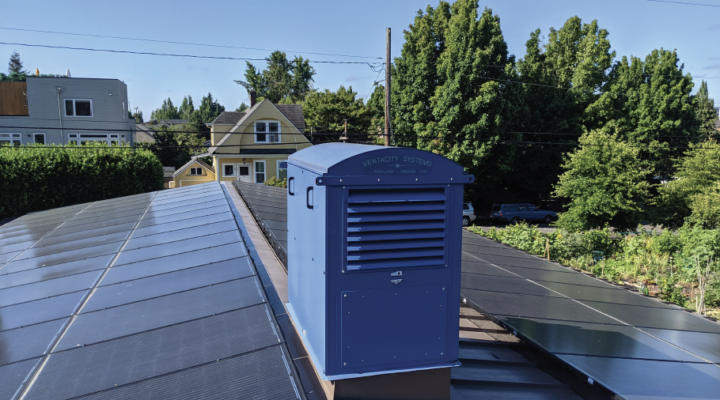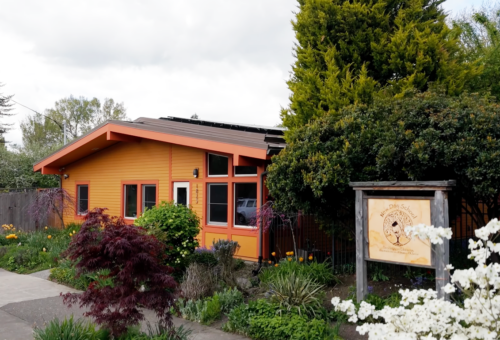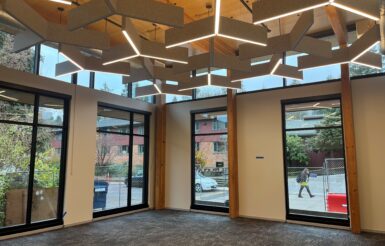In operation for more than 40 years, New Day School has a deep commitment to environmentally friendly and sustainable practices. When New Day School’s Kishalay building required a renovation, the preschool’s leadership team quickly committed to adopting advanced practices and products to ensure the renovations would result in a net-zero energy building.
Project Overview
Preschool matches efficient building practices with net-zero ambitions.
In operation for more than 40 years, New Day School is a longstanding Portland, Oregon, preschool with a deep commitment to environmentally friendly and sustainable practices. When New Day School’s Kishalay building required a renovation, the preschool’s leadership team quickly committed to adopting advanced practices and products to ensure the renovations would result in a net-zero energy building.
In addition to applying passive building principles that optimize heat gains and losses throughout the building, the building operators added a 45.5 kW solar photovoltaic (PV) system that provides enough annual energy for two buildings at the preschool.
With these decisions in place, the preschool needed a highly efficient HVAC system to reduce HVAC energy use while improving the indoor air quality and maintaining a high level of comfort for students, teachers and staff. Following guidance from their contractor, Green Hammer, the preschool found the ideal HVAC solution with a very high efficiency dedicated outside air system (very high efficiency DOAS).

High-performance HVAC puts energy waste in time-out.
Representing the next step in the ongoing evolution of HVAC design, very high efficiency DOAS utilizes the most efficient HVAC systems and design principles to provide better indoor air, while reducing commercial building HVAC energy use by an average of 69%.
Very high efficiency DOAS combines high-efficiency HVAC equipment with the dedicated outside air system (DOAS) approach that separates heating and cooling from the ventilation. This separation allows for optimal and efficient control of each of these critical building functions. The system utilizes a heat recovery ventilator (HRV) to extract/reject heat from the stale indoor air, and brings in 100% fresh, filtered outdoor air throughout the building.
The result is a healthy and efficient HVAC solution that reduces overall commercial building energy use by an average of 48%.
And, by significantly reducing or eliminating the recirculation of air between spaces, very high efficiency DOAS reduces the recirculation of pollutants and contaminated air to improve occupant health, comfort and overall satisfaction.
The school’s new HVAC system benefits the students, teachers, staff and building operators by providing:
- Better indoor air quality due to filtered 100% outside air being brought into the space, with little recirculation
- Increased occupant comfort through improved temperature stability and the ability to create zones with unique temperature controls
- Improved occupant productivity by improving indoor air quality and comfort
- Lower energy bills
Conversion summary:
| Pre-existing HVAC system: | Constant volume 5-ton packaged heat pump rooftop unit |
| New HVAC system: | 2x 1.5-ton ductless heat pumps 1x 2-ton ducted mini-split heat pump 1 Ventacity VS1000RT HRV |
Healthier air without the energy waste.
By providing 100% filtered outside air, the very high efficiency DOAS system decreases contaminant spread. This healthy upgrade to enhanced ventilation helps dilute the concentration of virus-containing aerosols that can remain suspended in stagnant building air. In this way, very high efficiency DOAS could reduce the spread of infectious diseases like Covid-19.
However, unlike competing high-ventilation HVAC systems, very high efficiency DOAS does not increase energy costs despite providing 100% filtered outside air. Very high efficiency DOAS combines high-efficiency design principles and with high-efficiency products, such as an HRV with heat recovery and ultra high-efficiency fans, to keep energy use down. For example, the Ventacity VS1000RT HRV installed at New Day School constantly changes ventilation rates by monitoring CO2 levels to know when buildings are unoccupied. By reducing ventilation rates when children and staff are outside, the HRV helps the building efficiently provide excellent indoor air quality, instead of unnecessarily running at full speed regardless of occupancy.
Data sources:
- Based on twelve real-world demonstration projects by Northwest Energy Efficiency Alliance, as compared to code-minimum systems.
- Based on findings from NEEA’s 2021 Covid-19 Risk Reduction Strategies and HVAC System Energy Impact Report: betterbricks.com/resources/covid-19- hvac-risk-reduction-strategies.
- Reported GHG emissions reduction is based on the following assumptions: 1) 11.7 pounds of CO2 per therm of natural gas saved, 2) 0.91 pounds of CO2 per kWh avoided (Northwest Power and Conservation Council’s latest report from 2018 on avoided CO2 rates in the Northwest).



